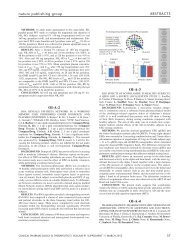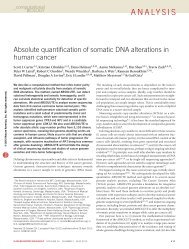open access: Nature Reviews: Key Advances in Medicine
open access: Nature Reviews: Key Advances in Medicine
open access: Nature Reviews: Key Advances in Medicine
Create successful ePaper yourself
Turn your PDF publications into a flip-book with our unique Google optimized e-Paper software.
NEUROLOGY<br />
Compet<strong>in</strong>g <strong>in</strong>terests<br />
The authors declare no compet<strong>in</strong>g <strong>in</strong>terests.<br />
1. Cordonnier, C. & van der Flier, W. M. Bra<strong>in</strong><br />
microbleeds and Alzheimer’s disease: <strong>in</strong>nocent<br />
observation or key player? Bra<strong>in</strong> 134, 335–344<br />
(2011).<br />
2. Henneman, W. J. et al. MRI biomarkers of<br />
vascular damage and atrophy predict<strong>in</strong>g<br />
mortality <strong>in</strong> a memory cl<strong>in</strong>ic population. Stroke<br />
40, 492–498 (2009).<br />
3. Yates, P. A. et al. Cerebral microhemorrhage<br />
and bra<strong>in</strong> β‑amyloid <strong>in</strong> ag<strong>in</strong>g and Alzheimer<br />
disease. Neurology 77, 48–54 (2011).<br />
4. Goos, J. D. C. et al. Microbleeds relate to<br />
altered amyloid‑β metabolism <strong>in</strong> Alzheimer<br />
disease. Neurobiol. Ag<strong>in</strong>g http://dx.doi.org/<br />
10.1016/j.neurobiolag<strong>in</strong>g.2011.10.026.<br />
EPILEPSY IN 2011<br />
Insights <strong>in</strong>to epilepsy treatments<br />
and biomarkers<br />
Fernando Cendes<br />
Research published <strong>in</strong> 2011 identified important factors related to<br />
serious adverse effects of antiepileptic drugs and sudden unexpected<br />
death <strong>in</strong> epilepsy, along with a potential new treatment and a promis<strong>in</strong>g<br />
marker of epileptogenesis. Further advances <strong>in</strong> these areas are urgently<br />
needed to improve the lives of people with epilepsy.<br />
Cendes, F. Nat. Rev. Neurol. 8, 70–71 (2012); published onl<strong>in</strong>e 10 January 2012;<br />
doi:10.1038/nrneurol.2011.223<br />
Epilepsy affects people of all ages, is<br />
highly prevalent, and can have a good<br />
out come with appropriate anti epileptic<br />
drugs (AEDs). However, seizures are<br />
often refractory to cl<strong>in</strong>ical treatment, with<br />
detrimental—and even life-threaten<strong>in</strong>g—<br />
consequences. 1 Unpredictable events,<br />
such as serious adverse effects of AEDs<br />
and sudden unexpected death <strong>in</strong> epilepsy<br />
(SUDEP), make this condition even harder<br />
to manage. The fact that epilepsy still carries<br />
a great stigma, with many people hid<strong>in</strong>g<br />
their condition, h<strong>in</strong>ders public awareness<br />
and, <strong>in</strong> addition, makes it more difficult for<br />
the condition to be recog nized as a serious<br />
public health problem, result<strong>in</strong>g <strong>in</strong> reduced<br />
availability of research resources compared<br />
with other common diseases. Despite such<br />
obstacles, however, considerable advances<br />
are be<strong>in</strong>g made on a number of fronts, as<br />
illustrated by several key papers published<br />
dur<strong>in</strong>g 2011.<br />
Sudden unexpected death is 20 times<br />
more frequent <strong>in</strong> people with epilepsy<br />
than <strong>in</strong> the general population, but the risk<br />
factors identified for SUDEP have not been<br />
consistent across the literature. A recent<br />
study by Hesdorffer et al. has helped to identify<br />
groups of people with epilepsy who are<br />
5. Altmann–Schneider, I. et al. Cerebral<br />
microbleeds are predictive of mortality <strong>in</strong> the<br />
elderly. Stroke 42, 638–644 (2011).<br />
6. Sperl<strong>in</strong>g, R. A. et al. Amyloid‑related imag<strong>in</strong>g<br />
abnormalities <strong>in</strong> amyloid‑modify<strong>in</strong>g therapeutic<br />
trials: recommendations from the Alzheimer’s<br />
Association Research Roundtable Workgroup.<br />
Alzheimers Dement. 7, 367–385 (2011).<br />
7. Goos, J. D. C. et al. Cl<strong>in</strong>ical relevance of<br />
improved microbleed detection by<br />
susceptibility‑weighted magnetic resonance<br />
imag<strong>in</strong>g. Stroke 42, 1894–1900 (2011).<br />
8. De Reuck, J. et al. Comparison of 7.0‑T T 2 *‑<br />
magnetic resonance imag<strong>in</strong>g of cerebral bleeds<br />
<strong>in</strong> post‑mortem bra<strong>in</strong> sections of Alzheimer<br />
patients with their neuropathological<br />
correlates. Cerebrovasc. Dis. 31, 511–517<br />
(2011).<br />
‘‘ The currently available AEDs<br />
do not prevent or cure epilepsy,<br />
and are merely antiseizure<br />
medications<br />
at particular risk of SUDEP. 2 In this pooled<br />
analysis of four case–control studies, earlyonset<br />
refractory symptomatic epilepsy, frequent<br />
generalized tonic–clonic seizures, and<br />
use of AED polytherapy were all found to<br />
be significant risk factors for SUDEP. Such<br />
studies are extremely important for draw<strong>in</strong>g<br />
attention to the need to achieve complete<br />
seizure control <strong>in</strong> people with epilepsy.<br />
The currently available AEDs do not<br />
prevent or cure epilepsy, and are merely<br />
antiseizure medications. This fact underscores<br />
our lack of knowledge about the<br />
exact mechanisms of seizure genesis and<br />
modes of action of AEDs. In this context,<br />
a paper by Jeon et al. 3 was another important<br />
publication <strong>in</strong> 2011. The researchers<br />
studied the effects of cell-free extract<br />
derived from human adipose stem cells<br />
(ASCs) on the acute and chronic phases of<br />
the pilocarp<strong>in</strong>e epilepsy model <strong>in</strong> mice. 4<br />
’’<br />
Pretreatment with the extract did not affect<br />
seizure susceptibility to pilocarp<strong>in</strong>e, but it<br />
did reduce the number of EEG spikes <strong>in</strong> the<br />
acute phase, and subsequently dim<strong>in</strong>ished<br />
sponta neous recurrent seizures (SRS) <strong>in</strong><br />
the chronic epileptic stage. 3 Furthermore,<br />
cont<strong>in</strong>u<strong>in</strong>g treatment <strong>in</strong> the chronic epileptic<br />
stage suppressed or <strong>in</strong>hibited SRS and<br />
had a positive effect on animal behavioral<br />
tests. In addition, animals treated with the<br />
extract had less damage to blood–bra<strong>in</strong><br />
barrier <strong>in</strong>tegrity than did untreated controls.<br />
Interest<strong>in</strong>gly, heat-treated ASC extract had<br />
no beneficial effect, suggest<strong>in</strong>g the importance<br />
of cytosolic prote<strong>in</strong>s <strong>in</strong> the positive<br />
effects of this agent.<br />
Studies have suggested that stem or<br />
precursor cells may rescue degenerat<strong>in</strong>g<br />
neurons by modulat<strong>in</strong>g the host environment<br />
via a chaperone-like mechanism, or<br />
by alter<strong>in</strong>g immune-like functions <strong>in</strong>clud<strong>in</strong>g<br />
<strong>in</strong>flammatory responses. 5 Thus, some<br />
cell-based therapies might rely more on a<br />
‘bystander’ mechanism <strong>in</strong>volv<strong>in</strong>g secretion<br />
of soluble factors—such as cytok<strong>in</strong>es<br />
and chemok<strong>in</strong>es—than on replacement of<br />
damaged neurons by neurogenesis. 3 The<br />
ASC extract used by Jeon et al. may act by<br />
modulat<strong>in</strong>g <strong>in</strong>flammatory events dur<strong>in</strong>g<br />
epileptogenesis. 3<br />
Dur<strong>in</strong>g 2011, important contributions<br />
were also made to our understand<strong>in</strong>g of<br />
serious adverse effects of AEDs, <strong>in</strong>clud<strong>in</strong>g<br />
risks of allergic reactions and teratogenesis.<br />
6,7 Carbamazep<strong>in</strong>e, one of the most<br />
important AEDs, causes various forms of<br />
hypersensitivity reaction, rang<strong>in</strong>g from<br />
maculopapular exanthema to severe<br />
and potentially lethal conditions such as<br />
Stevens–Johnson syndrome and toxic epidermal<br />
necrolysis (SJS–TEN). In a key<br />
publication, McCormack et al. 6 showed<br />
that the presence of the HLA-A*3101<br />
allele is associated with carbamazep<strong>in</strong>e<strong>in</strong>duced<br />
hypersensitivity reactions among<br />
Europeans. The overall prevalence of carbamazep<strong>in</strong>e<br />
hypersensitivity is 5.0%; presence<br />
of the HLA-A*3101 allele <strong>in</strong>creased the<br />
risk to 26.0%, whereas absence of the allele<br />
reduced the risk to 3.8%. Another HLA<br />
allele, HLA-B*1502, is strongly correlated<br />
with carbamazep<strong>in</strong>e-<strong>in</strong>duced SJS–TEN <strong>in</strong><br />
Asian populations but not <strong>in</strong> Europeans. 8<br />
Another serious adverse effect of AEDs is<br />
the <strong>in</strong>creased risk of malformations <strong>in</strong> the<br />
offspr<strong>in</strong>g of women who use these medications<br />
dur<strong>in</strong>g pregnancy. Clear evidence is<br />
available that some AEDs, such as valproic<br />
acid, pose major risks of terato genesis, and<br />
the perception is that some of the newer<br />
AEDs, <strong>in</strong>clud<strong>in</strong>g lamotrig<strong>in</strong>e, could be safer.<br />
S62 | JANUARY 2012 www.nature.com/reviews








